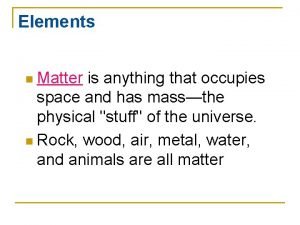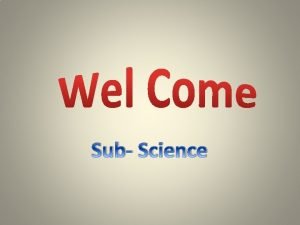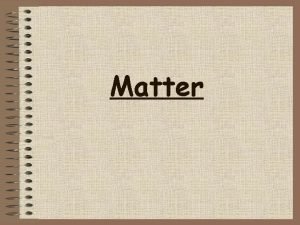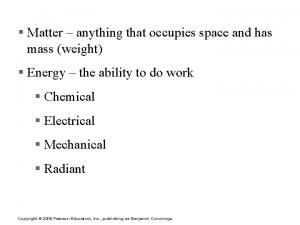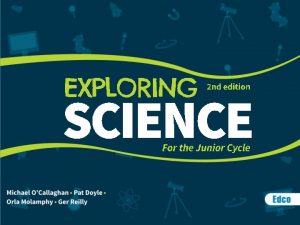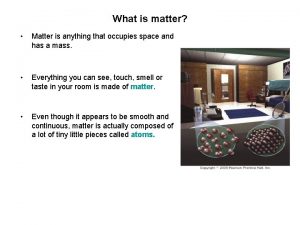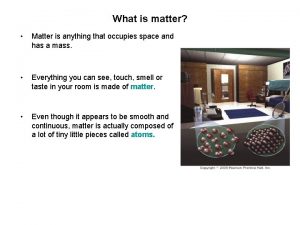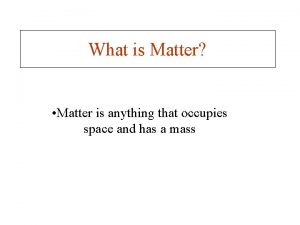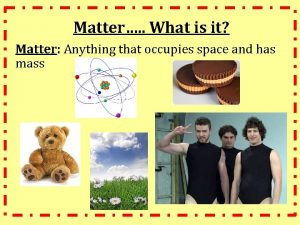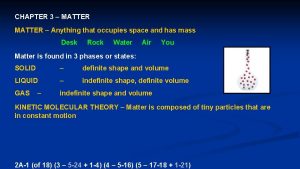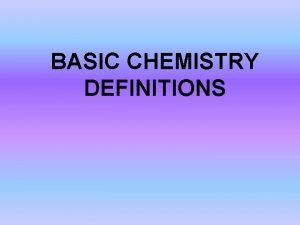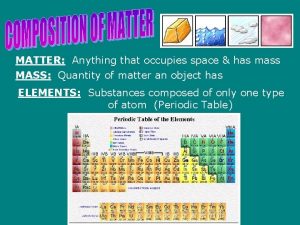Environmental Systems Chapter 2 Matter anything that occupies

















- Slides: 17

Environmental Systems Chapter 2

Matter “anything that occupies space and has mass” • • Atoms Molecules Periodic Table Atomic Number http: //science. howstuffworks. com/laser 1. htm

• No atoms are ever destroyed or created, but the bonds may change between them a. law of conservation of matter - “ matter cannot be created or destroyed; it can only change form”

Radioactivity • Unstable isotopes are radioactive • Radioactive decay a. spontaneous release of material from nucleus ex) Uranium-235 (235 U) • Half-life a. measurement of radioactive decay

Chemical Bonds • Covalent Bonds (sharing of e-) a. CH 4 (methane) • Ionic Bonds (transfer of e-) a. Na. Cl (salt) • Hydrogen Bonds (unequal sharing of e-) a. weak b. H 2 O

Properties of Water • • Surface tension Capillary action Boiling and freezing point Acts as a solvent http: //environment. nationalgeographic. com/environment/photos/freshwater-insects/

p. H • Acid a. dissociates into positively charged H+ and negatively charged ions b. HNO 3 and H 2 SO 4 • Base a. dissociates into negatively charged OH- ions and positively charged ions b. Na. OH http: //sanibelseaschool. org/classroom/ph

Organic Molecules • Organic v. Inorganic Compounds • Examples of Organic Compounds a. Carbohydrates b. Lipids c. Proteins d. Nucleic Acids

Energy • “ability to do work, or transfer heat” • Majority on Earth derives from the Sun

Forms of Energy • Joule: basic unit of energy (J) • Energy and Power a. energy-ability to do work power-rate at which work is done therefore, energy = power X time power = energy / time

• Kinetic and Potential Energy a. Potential-stored energy not yet released ex) water behind a dam b. Kinetic-energy of motion ex) electricity created from water captured by dam

Energy Laws • 1 st Law of Thermodynamics a. “energy is neither created nor destroyed” b. ex) Dams • 2 nd Law of Thermodynamics a. “when energy is transformed, the quantity of energy remains the same but its ability to do work diminishes”

b. energy efficiency c. energy quality - high v. low quality energy d. entropy e. global circulation patterns powered by Sun

Systems • Open System a. exchange of matter or energy across system boundaries ex) ocean • Closed System a. matter and energy exchange across the boundaries does not happen ex) underground cave system

• Input a. additions to a system • Output a. losses from the system

Steady State • “inputs equal outputs so that the system is not changing over time” • Allows us to know if the amount of a resource or pollutant is increasing, decreasing or staying the same

Feedbacks • Positive Feedback Loop a. amplifies change b. births in regards to human population • Negative Feedback Loop a. responds to a change by returning to its original state to reach homeostasis b. thermostat
 Is anything that occupies space and has mass.
Is anything that occupies space and has mass. Matter is anything that occupies space and has -----------
Matter is anything that occupies space and has ----------- Matter is anything that:
Matter is anything that: It is anything that has mass and occupies space
It is anything that has mass and occupies space It is anything that has mass and occupies space
It is anything that has mass and occupies space Phân độ lown ngoại tâm thu
Phân độ lown ngoại tâm thu Block nhĩ thất độ 1
Block nhĩ thất độ 1 Thơ thất ngôn tứ tuyệt đường luật
Thơ thất ngôn tứ tuyệt đường luật Thơ thất ngôn tứ tuyệt đường luật
Thơ thất ngôn tứ tuyệt đường luật Chiến lược kinh doanh quốc tế của walmart
Chiến lược kinh doanh quốc tế của walmart Tìm vết của đường thẳng
Tìm vết của đường thẳng Con hãy đưa tay khi thấy người vấp ngã
Con hãy đưa tay khi thấy người vấp ngã Tôn thất thuyết là ai
Tôn thất thuyết là ai Gây tê cơ vuông thắt lưng
Gây tê cơ vuông thắt lưng Sau thất bại ở hồ điển triệt
Sau thất bại ở hồ điển triệt Chapter 2 matter section 1 classifying matter answer key
Chapter 2 matter section 1 classifying matter answer key Anything that has mass and takes up space
Anything that has mass and takes up space Matter anything that
Matter anything that


